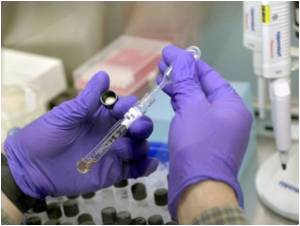Computer-designed proteins can be engineered to act as antiviral agents against a variety of influenza virus strains, suggests study.

"'One of these engineered proteins has a flu-fighting potency that rivals that of several human monoclonal antibodies," Dr. David Baker, professor of biochemistry at the University of Washington, said
Baker's research team is making major inroads in optimising the role of computer-designed influenza inhibitors.
These proteins are designed via computer modeling to fit exquisitely into a specific nano-sized target on flu viruses.
By binding the target region, they keep the virus from altering shape, a tactic that the virus uses to infect the living cells. The research efforts are made possible by computers that can describe the landscapes of forces involved on the sub microscopic level.
The team of researchers is engineering novel proteins with new functions for specific purposes in medicine, environmental protection and other fields.
Advertisement
The flu is one of the key interests of the Institutes for Protein Design and its collaborators in the United States and abroad, because influenza is a serious worldwide public health concern due to its genetic shifts and drifts that periodically become more virulent.
Advertisement
Vaccines for new strains of influenza take months to develop, test and manufacture, and are not helpful for those already ailing. The long response time for vaccine creation and distribution is unnerving when a more deadly strain suddenly emerges and spreads rapidly.
Moreover, the speed of transmission is accelerated by the lack of widespread immunity in the general population to the latest form of the virus.
The strains of flu are referred to by their H and N subtypes. H stands for hemagglutinins, which are the molecules on the flu virus that allow it to invade the cells of respiratory passages.
The virus's hemagglutinin molecules append itself to the surface of cells lining the respiratory tract.
When the cell tries to swallow up the virus, it makes the mistake of drawing it into a more acidic location. The drop in pH alters the shape of the viral hemagglutinin, thereby allowing the virus to fuse to the cell and open an entry for the virus' RNA to come in and start making fresh viruses.
Now, the hypothesis is that the Baker Lab protein inhibits this shape change by binding the hemagglutinin in a very specific orientation and thus keeps the virus from invading cells.
Baker and his team wanted to create antivirals that could react against a wide variety of H subtypes, as this flexibility could lead to a comprehensive therapy for influenza.
However, their specific targets are viruses that have hemagglutinins of the H2 subtype and are responsible for the deadly pandemic of 1957 and continued to circulate until 1968.
People who were born after that date haven't been exposed to H2 viruses. The recent avian flu possesses a new version of H1 hemagglutinin. Data reveal that Baker's proteins bind to all types of the Group I Hemagglutinin, a group that includes not just H1 but the pandemic H2 and avian H5 strains.
According to Baker, the methods developed for the influenza inhibitor protein design, could be "'a powerful route to inhibitors or binders for any surface patch on any desired target of interest."'
Baker insists that if a new disease pathogen arises, scientists could figure out how it interacts with human cells or other hosts on a molecular level. Scientists could then use protein interface design to generate a diversity of small proteins that they predict would block the pathogen's interaction surface.
Genes for huge numbers of the most promising, computer-designed proteins could be tested using yeast cells.
After further molecular chemistry studies to find the best binding among those proteins, those could be re-programmed in the lab to go through mutations, and all the mutated forms could be stored in a "'library"' for an in-depth analysis of their amino acids, molecular architecture and energy bonds.
Advanced technologies would allow the researches to quickly thumb through the library to pick out those tiny proteins that clung to the pathogen surface target with pinpoint accuracy.
The finalists would be chosen from this pool for excelling at stopping the pathogen from attaching to, entering and infecting human or animal cells.
The use of deep sequencing, the same technology now used to sequence human genomes cheaply, was especially vital in creating detailed maps relating sequencing to function.
These maps were used to reprogram the design to achieve a more accurate interaction between the inhibitor protein and the virus molecule.
The scientists claimed that It also enabled them "'to leapfrog over bottlenecks"' to improve the activity of the binder.
They were able to see how small contributions from many tiny alterations in the protein, too difficult to spot individually, could together create a binder with better attachment strength.
"'We anticipate that our approach combining computational design followed by comprehensive energy landscape mapping will be widely useful in generating high-affinity and high-specificity binders to a broad range of targets for use in therapeutics and diagnostics,"' Baker added.
This study has been published in the Nature Biotechnology.
Source-ANI












